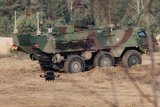Finnish Defence Forces continue software development of tactical communications system
Bittium has received a purchase order from the Finnish Defence Forces to develop a new software version for the company’s Tactical Wireless IP Network (TAC WIN) system.
In a 1 July statement, Bittium said the order continues the performance enhancements of the software-defined radio-based TAC WIN system based on the observations made during field testing and training, and waveform research done by the company.
Valued at some €2.3 million, the order includes options for additional purchases, with the ordered development work to be carried out by mid-2022.
The TAC WIN system provides broadband IP connectivity for the Finnish Defence Forces’ mobile communication stations and command posts.
‘The system supports the Finnish Defence Forces’ combat doctrine where mobility, leading the troops on the move, and effective communications play a key role. The resilient and modular system is used by all three service branches of the Finnish Defence Forces,’ Bittium said in the statement.
With the TAC WIN system, MANET (mobile ad hoc network), link, and connection networks can be formed into one logical IP network quickly, no matter what the location is.
Related Equipment in Defence Insight
More from Digital Battlespace
-
![Babcock nears first customer for Nomad AI translation tool]()
Babcock nears first customer for Nomad AI translation tool
Nomad can provide militaries with real-time intelligence, saving critical time on the battlefield.
-
![AUSA 2025: Israel’s Asio Technologies to supply hundreds of improved Taurus tactical systems]()
AUSA 2025: Israel’s Asio Technologies to supply hundreds of improved Taurus tactical systems
Taurus operates alongside the Israel Defense Forces’ Orion system which supports mission management across tens of thousands of manoeuvring forces, from squad leaders to battalion commanders.
-
![AUSA 2025: Kopin pushes micro-LED plans as China moves faster]()
AUSA 2025: Kopin pushes micro-LED plans as China moves faster
The plan for the new displays follows fresh investment in Kopin’s European facilities by Theon and an order for head-up displays in fielded aircraft, with funding from the US Department of Defense.
-
![AUSA 2025: Persistent Systems to complete its largest order by year’s end]()
AUSA 2025: Persistent Systems to complete its largest order by year’s end
Persistent Systems received its largest ever single order for its MPU5 devices and other systems earlier this month and has already delivered the 50 units to the US Army’s 4th Infantry Division.
-
![Aselsan brings in dozens of companies and systems under the Steel Dome umbrella]()
Aselsan brings in dozens of companies and systems under the Steel Dome umbrella
Turkey has joined the family of countries attempting to establish a multilayered air defence system with government approval in August 2024 for the effort landed by Aselsan. Dubbed Steel Dome, the programme joins Israel’s Iron Dome, the US Golden Dome, India’s Mission Sudarshan Chakra and South Korea’s low-altitude missile defence system.
-
![DSEI 2025: MARSS unveils new agnostic multidomain C4 system]()
DSEI 2025: MARSS unveils new agnostic multidomain C4 system
MARSS’ NiDAR system has been deployed using sensors from static platforms to provide detection and protection for static sights, such as critical infrastructure, ports and military bases.




























